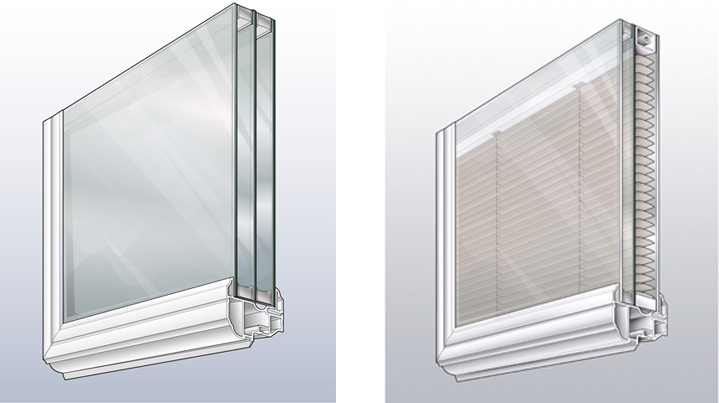The average homeowner is not going to be an expert on windows, but you may know what you want. Maybe you’re looking to bring down your energy bills but don’t want to break the bank. Below we’ve provided you with an unbiased explanation of everything you need to look for in window replacement for your home.
How do you know it’s time for new windows?
- The obvious, they do not open anymore, or are painted shut.
- Rot, deterioration or holes anywhere on your window or frame.
- Draft from your window when it’s closed. (Tip – circle the frame of your window with a flame of a lighter or candle slowly and see if the flame is disturbed by any air movement.
- Water condensation, frost and ice buildup.
Window Frame Material Types:

Solid Wood Windows
Wood windows (if new) can add the most value to your home and are the most aesthetically pleasing. They are also a great insulator to keep the cold (or heat) from transferring into your home. Wood comes at a higher cost, because of the expense of natural wood and general maintenance it will require. If not properly maintained, they can be prone to rotting.

Wood/Clad Windows
Clad Windows are generally wood windows that have and exterior layer of cladding or protection. These are among some of the most energy efficient and durable. The wood frame minimizes thermal conductivity and you get the beauty of real wood on your interior. The exterior shell can be made of vinyl or aluminum and reduces maintenance that would be needed if it was only a wood window. This is at the higher end of the budget, because you’re getting the beauty and warmth of a wood window and the longevity from the exterior cladding.

Fiberglass Windows
Fiberglass windows are very strong and have a long lifespan. They’re built to mimic the look and feel of wood, but without the maintenance. They are paintable, have great thermal performance and are low maintenance. Only cons to this window material is that they may need maintenance if you choose to paint them and are on the higher end of the budget, but for good reason.

Vinyl Windows
Vinyl windows are affordable and low maintenance, a popular choice when looking for the middle of the ground product and they will never rot. In comparison to aluminum, vinyl does not conduct heat or cold and are better at reducing outside noise. However there are some drawbacks: vinyl is known to expand and contract in hot and cold conditions, leaving the seals vulnerable to gaps and holes. Vinyl can fade, will get brittle with age and can not be painted over.

Aluminum Windows
Aluminum windows are strong, affordable and low-maintenance. Some of the downsides is that aluminum is a high thermal conductor. This is not desirable in colder climates in which condensation and frost can form. A solution to that is a break between the materials, keeping the exterior and interior aluminum separate.

Composite
Composite windows are another low maintenance option. They combined many different strengths and materials offered in many colors. Composite windows are offered by few manufacturers, and durability may vary depending on what types of composites are used.

Steel Windows
If you are looking for an industrial look, steel windows may be right for you. They are very strong and durable at the higher end of the budget and conductor of heat and the cold.
Window Glass Types:
Low-emissivity (low-E) Glass Coatings
This window glass has a thin metallic coating that reflects heat from the sun. Low-E coatings reduce energy costs and block UV rays while still allowing 95% of natural light to enter your home. Low-E can reduce energy loss by as much as 30% to 50% (according to energy.gov).

Single-pane Window
A single-paned window is one sheet of glass that is framed in any of the materials above. This type is usually at a lower cost, but less energy efficient compared to double-paned windows.
Double-pane Window
Double-paned windows are two sheets of glass side-by-side with 1/4 to 1 inch of air (or gas) between them. Heat during the summer or cold during the winter, will get trapped between the panes making it harder for the transfer of energy back and forth.
Triple-pane Window
Triple-paned windows are three sheets of glass with two spaces of air (or gas) between them for maximum energy efficiency.
Gas Filled
The gaps between the double and triple-paned windows are most often filled with gas (argon or krypton) these gases improve thermal performance and make it harder for heat transfer.

Heat-Absorbing Window Tints
Tinted glass can absorb a large amount of incoming solar radiation from the sun reducing heat transfer into your home and it will reduce glare.
Between-the-glass Blinds Window
This is a unique window that has blinds between 2 pieces of glass. It deserved a mention in the glass section because not only does it help with energy efficiency, it is a noise buffer and reduces indoor allergens and cleaning.

Window Styles:
Double-Hung Windows
Double-hung windows are a popular choice because they have a classic look and open from both the bottom and the top. They also tilt from the top and bottom making them easy to clean.
Single-Hung Windows
Single-hung is the traditional style of window that only opens from the bottom. They are a great choice if you’re looking for a simple classic look.
Casement Windows
Casement windows provide a picture window look but with the ability to open with a crank allowing full height ventilation. Casement windows are popular for hard to reach areas, such as, above the sink or countertops. This style does protrude into other spaces so be aware of the placement when installing them.
Awning Windows
Awning windows are popular in basements when there is limited vertical space to the outside, or many are placed above or below fixed picture windows to add ventilation. Awning windows are also nice in light rains, because the opening is at the bottom and the window will act as a shield from the rain.
Sliding Windows
Sliding and sometimes called gliding windows are another great option, these are also popular for basements because they bring in a lot of light and meet egress requirements. This style of window doesn’t protrude into other spaces so it’s great near outdoor walkways and decks.
Fixed Picture Windows
Fixed windows do not open, but they are great if you want to frame your outdoor scenery. These windows can get larger in scale because they do not open, and can be more efficient without the concerns of open and closing and leaving air gaps.
Custom Window Styles
Most windows and replacement windows have standard sizes, but if you have an oddly shaped window or space, always talk to a professional to see what your options are, because there are several window manufacturers that can customize a window that is exactly what you’re looking for.
Extra Window Information:
R-value for Windows
R-value measures the resistance to heat flow. The higher the R-value the more resistant it is, meaning the more efficient your window is. If energy efficiency is high on your priority list then make sure you know the r-value of the window.
U-factor of a Window
U-factor is the rate of heat transfer from the inside to the outside of your home. The lower the u-factor number the more efficient it is.
Solar Heat Gain Coefficient (SHGC)
SHGC measures how much heat your home gains from the sun. The lower the SHGC, the less heat in your home is gained.
Quality Matters
Do not skimp on windows if your thinking of your home as an investment. Low quality windows will have:
- Failed seals
- Improperly spaced glass
- Poor manufacturing
Poor quality windows can lead to excessive heat transfer and condensation buildup that can lead to more problems to the integrity of the window and home.
Installation of a Home Window
Most manufacturers would not recommend anyone but a professional to install their windows, because installation is more important than the window itself. The best window on the market is useless if it’s improperly installed and sealed. Back up your investment and pay the extra for installation. Make sure to look for certified installers, not just someone on craigslist that says he can do it.
Buresh and Windows:
At Buresh we work with the customers needs and budget to find the best solution. We offer vinyl, wood and fiberglass, because we feel these window material types are the best in holding up in Iowa weather. We are a certified installer. Pella Windows are our top selling brand and we also offer Sunrise, Wincore and Tundra Windows.
We hope you found this window guide helpful in understanding all the details in replacement windows in the market. Contact us if you have any questions. Thank you!
